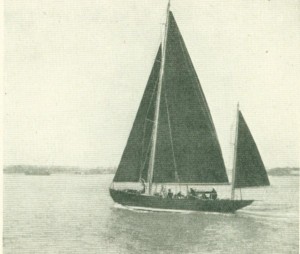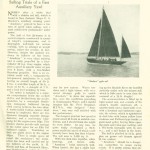“Amokura” – Sailing Trials of a Fast Auxiliary Yawl
NAMED after a white bird with a slender red tail, which is found in New Zealand, Major E. S. Harston’s auxiliary cruising yawl, “Amokura,” proved to have a fine turn of speed when sailing, and a most satisfactory performance under power.
The hull of this 23-tonner is in several respects constructed in excess of Lloyd’s requirements, and is thoroughly well-built for serious cruising, with no attempt at weight saving, rather the reverse, in fact. However, despite the modern tendency to fullness at the bows, “Amokura” is very clean running and is easily propelled by a four-cylinder 22 h.p. Gray engine, which gave a speed in smooth water of just over 6 knots, with a two-bladed Brunton propeller. This is an excellent result with a comparatively low-powered installation in a craft having an overall length of 50 ft. 3 ins., a waterline length of 38 ft., a beam of 12 ft., a draught of 7 ft., and a lead keel weighing 7½ tons.
The motor is installed in a separate compartment below the cockpit shelter, and divided from the accommodation by a watertight double-skin mahogany bulkhead having oiled canvas between the two skins. A water-cooled Cutless rubber shaft bearing is employed, there are two dynamos charging separate storage batteries, and a semi rotary bilge pump for the engine room bilge. Two wooden chocks provide safe carriage in the motor space for an Elto Pal outboard engine. Ventilators on deck are piped down to the engine bilges. There is ample space all around the machinery; the installation has been well carried out by the builders of the yacht, A. H. Moody and Son, of Swanwick Shore, near Southampton, and is above the average usually found in auxiliaries.
Saturday, May 20, fortunately proved to be an almost ideal sailing day for new canvas. Warm sunshine and a light breeze, with occasional stronger puffs to enable “Amokura” to show her capabilities, were the conditions prevailing in Southampton Water, and I should imagine that Mr. Fred Shepherd, M.I.N.A., who designed “Amokura,” was very well satisfied with her performance.
The designer puts her best speed at round about 10 knots in suitable conditions, and I should think she might do even better. At any rate, we quite easily overhauled a 70-ft, power yacht the speed of which could scarcely have been less than 8 knots. The sail area is 1,020 sq. ft.
With her dark blue topsides, white boot-top, and brown sails, “Amokura” looks extremely well. When heeled, she has a slight bow wave, but, apart from that, she scarcely leaves a ripple. The yacht is well balanced, light on the tiller, and steers herself “hands off.” Coming up the Hamble River she handled perfectly under only the mizzen sail, which is little more in area than the mainsail of a 14-ft. dinghy!
The accommodation is fitted up in light waxed oak, and consists of the owner’s double stateroom aft, a quarter bunk and a chart table over, with a lavatory and bathroom opposite; the saloon, which is upholstered in dark blue with lemon yellow loose cushions and Pullman-type berths; a good sized galley having three opening ports and Calor-gas cooking, and a two-berth forecastle with its own w.c., and a sail locker in the bows.
The hull is planked in 1¼-in. pitch pine on grown oak frames spaced 21 ins. centres.
“Amokura” should be a dangerous competitor in ocean racing events. It is pretty certain that she will be entered for the R.O.R.C. Channel Race, and just a chance that she may compete in this year’s Fastnet Race.
R.B.Y.
This article appeared in The Motor Boat and Yachting on 26 May 1939. Click the image below to see the original article.

